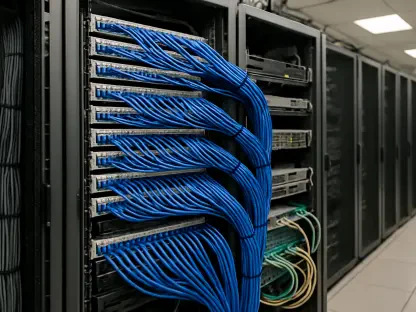Imagine discovering that your organization’s critical firewall system could be exploited by an attacker to gain unauthorized root-level access, potentially compromising sensitive data and disrupting operations. This scenario underscores the crucial importance of ensuring that security vulnerabilities in essential software, such as Palo Alto Networks’ PAN-OS, are promptly addressed. Recently, a high-severity authentication bypass vulnerability, identified as CVE-2025-0108, was uncovered in PAN-OS. This vulnerability has already been actively exploited, highlighting the need for comprehensive security measures to fend off opportunistic attackers.
Uncovering CVE-2025-0108
The Severity and Impact
Palo Alto Networks’ PAN-OS has been compromised by the high-severity authentication bypass vulnerability CVE-2025-0108, which represents a critical threat to enterprise network security. This particular vulnerability allows unauthenticated attackers with network access to the PAN-OS management web interface to bypass authentication mechanisms, thus gaining root-level access to the firewall system. Given that firewalls act as critical barriers against malicious activities, an attacker controlling these systems can potentially cause extensive damage across the network.
The severity of the CVE-2025-0108 vulnerability was evaluated using the Common Vulnerability Scoring System (CVSS), with a rating of 8.8 out of 10 when the management web interface is accessible from external IP addresses. This high score signals the significant risk posed when such interfaces are left exposed to untrusted networks. However, when access to these interfaces is limited to trusted IP addresses, the CVSS score drops to 5.9, indicating that restricting access can effectively mitigate some of the risks. This change in rating underscores the critical importance of securing access points to minimize potential exploitation.
Chaining with Older Vulnerabilities
The exploitation of CVE-2025-0108 is further compounded when it is chained with older vulnerabilities, specifically CVE-2024-9474 and CVE-2025-0111. When combined, these flaws can amplify the impact of an attack, enabling unauthorized individuals to gain root-level access. CVE-2024-9474 is categorized as a medium-severity vulnerability, while CVE-2025-0111 is rated as a high-severity flaw. Each of these previously reported vulnerabilities has a history of active exploitation, underscoring the persistent threat landscape facing organizations that fail to apply timely patches and updates.
By chaining these vulnerabilities together, attackers can create a sophisticated attack vector that significantly increases the damage potential. This strategy is particularly concerning as it demonstrates the evolving nature of cyber threats where adversaries continuously develop new methods to exploit well-known security gaps. Understanding the relevance of older vulnerabilities in conjunction with newer ones highlights the necessity of addressing a wide spectrum of security flaws within enterprise systems to ensure comprehensive protection against attacks.
Mitigation Strategies and Ongoing Vigilance
Prompt Patch Application
One of the most effective ways to defend against the exploitation of vulnerabilities such as CVE-2025-0108 is the prompt application of patches provided by the software vendor. Palo Alto Networks has issued patches to address this specific flaw, along with regular updates that seek to fortify PAN-OS against potential threats. Timely application of these patches is crucial to ensure that firewall systems are protected against known vulnerabilities that could be exploited by cyber attackers. Organizations should prioritize the deployment of these updates as part of their standard security protocols.
Despite the availability of patches, continuously evolving threats necessitate persistent vigilance and proactive measures. Cyber attackers are constantly developing new techniques to exploit security gaps, often targeting systems that are not updated regularly. This emphasizes the importance of establishing a robust patch management strategy that includes regular scanning and updating of all systems to prevent the exploitation of known vulnerabilities. Consistent application of patches forms the bedrock of an effective defense strategy in the ever-changing landscape of cybersecurity.
Restricting Access to Management Interfaces
Another critical mitigation strategy involves restricting access to the PAN-OS management web interface, particularly from external IP addresses. Limiting access to trusted IP addresses can significantly reduce the likelihood of unauthorized attempts to exploit the CVE-2025-0108 vulnerability. By implementing stringent access controls, organizations can minimize their attack surface and reduce the risk of a successful breach. This proactive measure is essential in ensuring that only authorized personnel can interact with critical management interfaces.
Moreover, deploying additional layers of security, such as multifactor authentication (MFA) and network segmentation, can further bolster defenses. MFA adds an extra step in the authentication process, making it more difficult for attackers to gain unauthorized access. Network segmentation, on the other hand, helps isolate critical systems from wider network traffic, thereby containing potential breaches and limiting the extent of damage. Combining these strategies with regular security assessments and monitoring can enhance overall network security and resilience against sophisticated attacks.
Assurance Through Palo Alto Networks’ Advisory
Cloud NGFW and Prisma Access Services
Palo Alto Networks has provided some reassurance to users of their Cloud NGFW and Prisma Access services, confirming that these products are not affected by the identified vulnerabilities. This advisory offers a level of comfort to organizations utilizing these services, as they can be assured that these critical components remain secure against the specific threats posed by CVE-2025-0108 and its associated flaws. Nevertheless, it is crucial to remain vigilant and ensure that all other systems within the network are similarly safeguarded.
While the advisory provides assurance for certain services, the importance of comprehensive security measures remains paramount for the overall network. Ensuring that all systems, including those not explicitly covered by the advisory, are regularly updated and patched is essential to maintaining robust protection. Organizations must adopt a holistic approach to security that encompasses all aspects of their infrastructure to defend against potential exploits effectively.
The Importance of Updated Security Measures
Imagine suddenly realizing that your organization’s vital firewall system is vulnerable to an attacker who could gain unauthorized root-level access. This breach could expose sensitive data and seriously disrupt your operations. This scenario emphasizes the critical importance of addressing security vulnerabilities in essential software like Palo Alto Networks’ PAN-OS without delay. Recently, a high-severity authentication bypass vulnerability, known as CVE-2025-0108, was discovered in PAN-OS. Alarmingly, this flaw has already been actively exploited by malicious actors. The presence of this vulnerability underscores the urgent need for robust security measures to defend against opportunistic attackers. Companies must prioritize regular software updates and security patches to safeguard their systems. By doing so, they can help mitigate the risks associated with such vulnerabilities and maintain the integrity and confidentiality of their critical data and operations.









